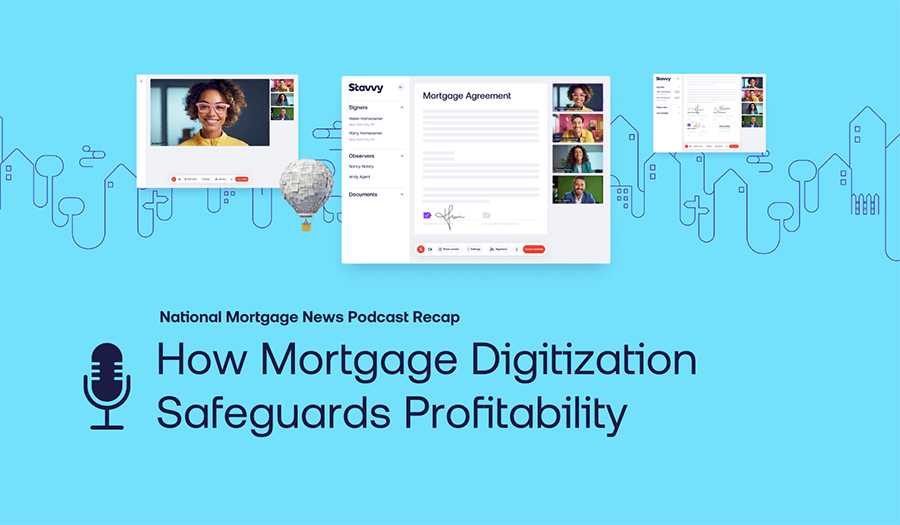On May 1, 2024, Stavvy sponsored a webinar hosted by the New York Mortgage Bankers Association. The discussion centered on emerging digital trends and technologies in the mortgage industry, such as eClosing, eNotes, SMART Docs®, digital default servicing, and other advancements aimed at enhancing efficiency, security, and customer satisfaction.
The Time for eClosing is Now
The webinar began by addressing a crucial question: why is now the right time for eClosing technology? Many factors are driving this shift. Five years ago, the necessary infrastructure was not as prevalent. The impact of COVID-19 accelerated the adoption of digital tools and capabilities essential for eClosing, such as high-speed internet and widespread use of video conferencing technologies.
Today, with innovations like Ginnie Mae's Digital Collateral Program and greater investor participation, the environment is more conducive to digital adoption. As a result, the use of eNotes has significantly increased, involving approximately 250 originators, 43 warehouse lenders, and 34 investors. This data, taken from the MERS eRegistry® participant list, affirms the growing acceptance of eClosing across various industry players.
Boosting Efficiency and Profitability with Digital Solutions
The Mortgage Bankers Association's Quarterly Mortgage Bankers Performance Report revealed that independent mortgage banks (IMBs) and mortgage subsidiaries of chartered banks incurred an average loss of over $2,000 per loan in Q4 2023. In light of these findings, the webinar addressed how eClosing can improve operational efficiency and profitability.
eClosing can reduce costs associated with manual processes and lost notes by eliminating the need for multiple quality control checks and lowering transactional costs. While the average warehouse dwell time for paper notes is around 10 to 15 days, eNotes can reduce this to just three to five days, or even as little as 24 to 36 hours in some cases.
eClosing can eliminate much of the post-closing quality control process by reducing post-closing errors and omissions, resulting in a potential savings of $200 to $400 per loan because there is no need to handle manual corrections.
Comparing Hybrid and Full eClosing Workflows
The discussion also compared hybrid and full eClosing workflows. Hybrid closings, where some documents are signed digitally in advance, are a common starting point for many lenders. The advantage of hybrid closings is that they can significantly reduce the time spent at the closing table from 50 minutes to about 15 minutes.
Consumers want flexibility. Having the capabilities for hybrid, in-person electronic notarization (IPEN), and remote online notarization (RON) allows lenders to meet consumers where they are. Some first-time homebuyers may want the in-person experience, while others, like seasoned buyers, may prefer the convenience of a fully digital process.
Enhancing Security and Compliance with MISMO Smart Docs®
MISMO Smart Docs® were introduced as a key component in enhancing digital mortgage efficiency and security. Smart Docs®, which are data-driven and verifiable, ensure that the data within a document is consistent and compliant. They enable lenders and investors to verify data across all documents, ensuring that what was seen and signed by the borrower is accurate and compliant
Integrating Smart Docs® throughout the entire mortgage document portfolio can modernize the verification process. Smart Docs® can automate data comparison, removing the need for manual quality control checks and significantly speeding up the post-closing process.
Digital Default Servicing: Improving the Homeowner Experience
The webinar concluded with a conversation about digital default servicing and how digital tools can simplify the loss mitigation process. Panelists highlighted the importance of providing distressed homeowners with transparent and flexible digital solutions, noting that digital platforms allow homeowners to upload documents, check the status of their applications, and communicate with servicers more efficiently.
Utilizing digital solutions in servicing can also help servicers stay compliant with changing regulations. Digital tools provide an audit trail that captures all activities and interactions, making it easier to demonstrate compliance to regulators.
Final Thoughts On The Future of Digital Mortgages
The webinar emphasized that by embracing digital tools and workflows, lenders can enhance efficiency, reduce costs, and improve the overall borrower experience. It highlighted the importance of meeting consumers online, where they prefer to conduct business digitally. It provided insights and practical advice for mortgage professionals looking to navigate the digital mortgage journey and use technology to stay competitive in a changing market.
Watch now: Embracing the Digital Mortgage Journey from Origination through Servicing
 today for more information on how Stavvy can help you navigate the digital mortgage journey.
today for more information on how Stavvy can help you navigate the digital mortgage journey.



![[Webinar Recap] Advancing Your Digital Default Servicing Strategy](https://blog.stavvy.com/hubfs/advancing-your-digital-default-servicing-strategy-blog-recap.png)